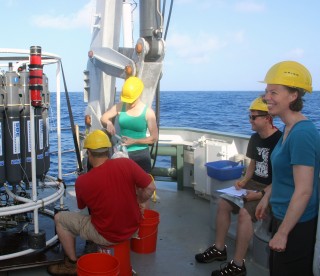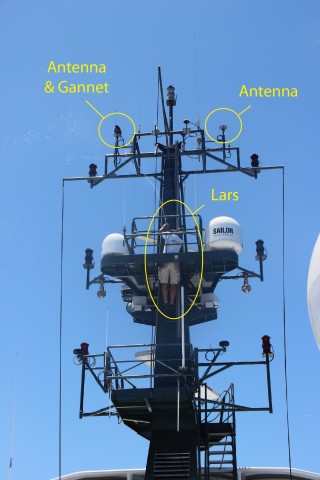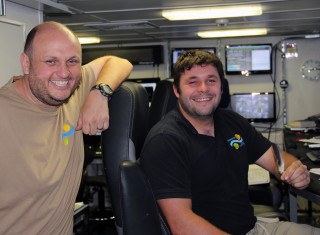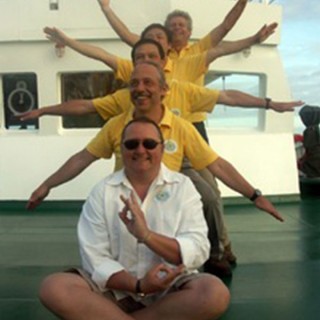Another good day today. I was up at 5am to join in with a CTD cast designed to land right over the hottest chimneys that we had mapped out at the Piccard hydrothermal field in 2012: at the Beebe Vents mound.

To avoid unnecessary wear and tear on the engines we avoided using our Dynamic Positioning system and, instead, using the acoustic tracking beacon we have mounted on the CTD we left it to the skill and judgement of the officers on the Bridge to do whatever they had to do with the ship to ensure the CTD icon on their navigation screen (the same image is relayed like a dedicated TV channel to screens in the lab and on the Bridge) lands directly over a target site that we enter into the program showing them, to the nearest 5m or so, where we want to collect our samples.
The first cast of the day worked out perfectly and we landed in what we could tell, from our sensors, were heated, smokey and chemically fresh plume waters. Having arrived to within 10m of the seafloor, we then proceeded to lift the CTD back up and Meg, who was to be the prime beneficiary (or maybe victim?) of this cast, selected depths at multiple heights within the plume from which to collect the suite of dedicated samples she likely only dreamed of getting when the cruise began. As soon as we had finished firing all our bottles, it was time to haul the CTD up to the surface where our science team was standing by ready to start sampling and processing everything – since the profile we collected was really rather special, we did collect a wide range of samples along with Meg’s core interests.

One continuous long siren = automatic fire alarm
Seven short then one long = proceed to emergency muster station on the boat deck
Short then long, short then long, repeated over and over = abandon ship.
Today we added a new one.
Three short then a squirt of water = G.O.G. (Gannet on GPS)Chris German
Once sampling was complete, it was time to go again, lowering the CTD down at the same site while Meg disappeared off to the wet lab – already a little tired, but seemingly very happy. We didn’t see much of Meg again the rest of the day but she was still going in the evening with one final set of instrument calibrations to complete before it was time to sleep. By that point she was more tired than happy, I suspect – but I bet she is gonna be happy when she wakes up and sees all the unique data she collected today. And in the nature of a true scientist, I bet it won’t be more than another day after that until she wants to do it all again!!!
Meantime, it was Cody-time. What can I say? The first time we tried back-to-back CTD casts at Piccard, the first cast landed right on the money for Meg and the second cast missed the plume completely because we were 20m off to the North. Today we tried a different tack. Knowing precisely where the different vent fields are on the seafloor, we lowered the CTD to a position about 50m to the South East and got ready to look for new rising plume water signals. Right on cue we saw anomalies in Ko-ichi’s Eh sensor. That meant we were in chemically fresh waters. Check! The temperature sensor also started warming up from the cold (refrigerator-like) temperatures of the deep ocean. So… chemically-rich, heated waters. Check!
But then, Ko-ichi pointed out that neither of our two optical sensors had budged at all. Hmmm. So not smokey, hot, chemically-enriched plume waters then. We rechecked the navigation display and sure enough we were positioned right over a different part of the Piccard field at the Beebe Sea mound where there is abundant life but only relatively low temperature fluid flow seeping out of cracks in the hillside. While these fulid temperatures are great for sustaining the weird life-forms around vents, they are not hot enough to transport large concentrations of dissolved metals that form the mineral precipitates that show up as “smoke” on the optical sensors on our CTD. Because this is his first research cruise, Cody hadn’t had the benefit of seeing what the Beebe Sea area looks like, up close and personal, before – but from the description I gave him we figured that all our real-time data from the CTD, including the tracking beacon, indicated that this was where we were and also that this was a pretty interesting location for him to take a first sample from – so he did.

Then we asked the ship to start moving us about 50m to the North West and an interesting thing happened. All our navigational data screen went dead. We had lost our highest quality Scientific GPS input and without that our acoustic tracking of the CTD just 10m above the seafloor had also failed. We hauled the CTD to 50m from bottom to make sure it was in a safe place, just hanging at the bottom of the ocean, while Leighton and Nathan went to work, trouble-shooting what the matter might be. After 5-10 minutes, meanwhile, Cody and Ko-ichi noticed that wherever we were near the seafloor, the CTD tracers had started showing that the CTD was drifting sideways into another set of plume waters with different characteristics and that these ones were not only warm and chemically “fresh” but, hallelujah, they were smokey too. We tripped all the remaining bottles and started to haul the CTD back on deck. Meantime, I walked up to the Bridge to explain what the perplexing situation was while Nathan prepared to check and recheck tens, even hundreds of meters of cabling from the GPS antenna all the way down to our labs to make sure there wasn’t a loose connection anywhere.
In parallel, Leighton stopped and thought deeply about all the information he had at his disposal. Then, just as I arrived on the Bridge to tell Paul what the situation was, a voice came over the radio (Leighton’s) saying:
“Hang on – can someone just take a look up at the main mast and make sure there isn’t some big fat seagull or something sitting on our antenna?”
The next voice we heard was Nathan’s:
“You’re not going to believe this….”
Enter Janet the non-gender-specific Gannet. Remember him/her? It had only been 24h earlier, during the preceding Nereus recovery, that Leighton and I remarked that we hadn’t seen Janet recently and concluded he/she must have departed for somewhere with better fishing capability. But no, apparently Janet had found an even better vantage point that before, now settling on the very tallest mast on the ship and making that their home.
So – how to dislodge her/him? First we tried sounding the ship’s whistle (more of a deep hoot) three times – that got plenty of people out on deck to see what was happening but Janet wasn’t moving. Then, enter our Boatswain, Lars with a hose of cold water. Climbing higher and higher up the mast ladder system, he eventually got close enough up underneat where Janet was perched (which was, indeed, right on top of our GPS antenna) so that the jet of water from the hose would reach that far and squirt upward to dislodge our friendly (but not super helpful) visitor. At last, Janet took flight – and will hopefully choose somewhere a little less unhelpful (English understatement) to perch when she/he returns.

